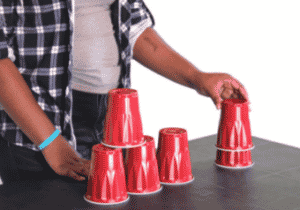Materials
Instructions
Translated activity PDFs
Students learn about force, load, and compression as they explore the load-bearing properties of columns by testing different materials within toilet paper tubes.


Using a predefined “robot programming vocabulary” (see below), students will write a program a student “robot” will follow to build cup pyramids as efficiently as possible without verbal conversation. Students learn how computer engineers use the connection between symbols and actions, as well as the valuable skill of debugging code. See examples of this activity in action by searching for “cup stacking coding” on YouTube.
Note: Coding and programming essentially have the same meaning. Both refer to the activity of providing any digital platform (like a PC, robot, or browser) a set of instructions on the tasks it needs to perform.




Enjoy this activity?
Join our community and receive activities, early access to programs, and other special news, and/or leave feedback on this activity below!
All of the content on this site is free!
Registering for the site helps us tailor future activities, webinars, and events so that we can serve you better.
Thank you for your interest and for helping us in our mission to transform lives as we put the E in STEM!
Thank you! Your submission is processing.